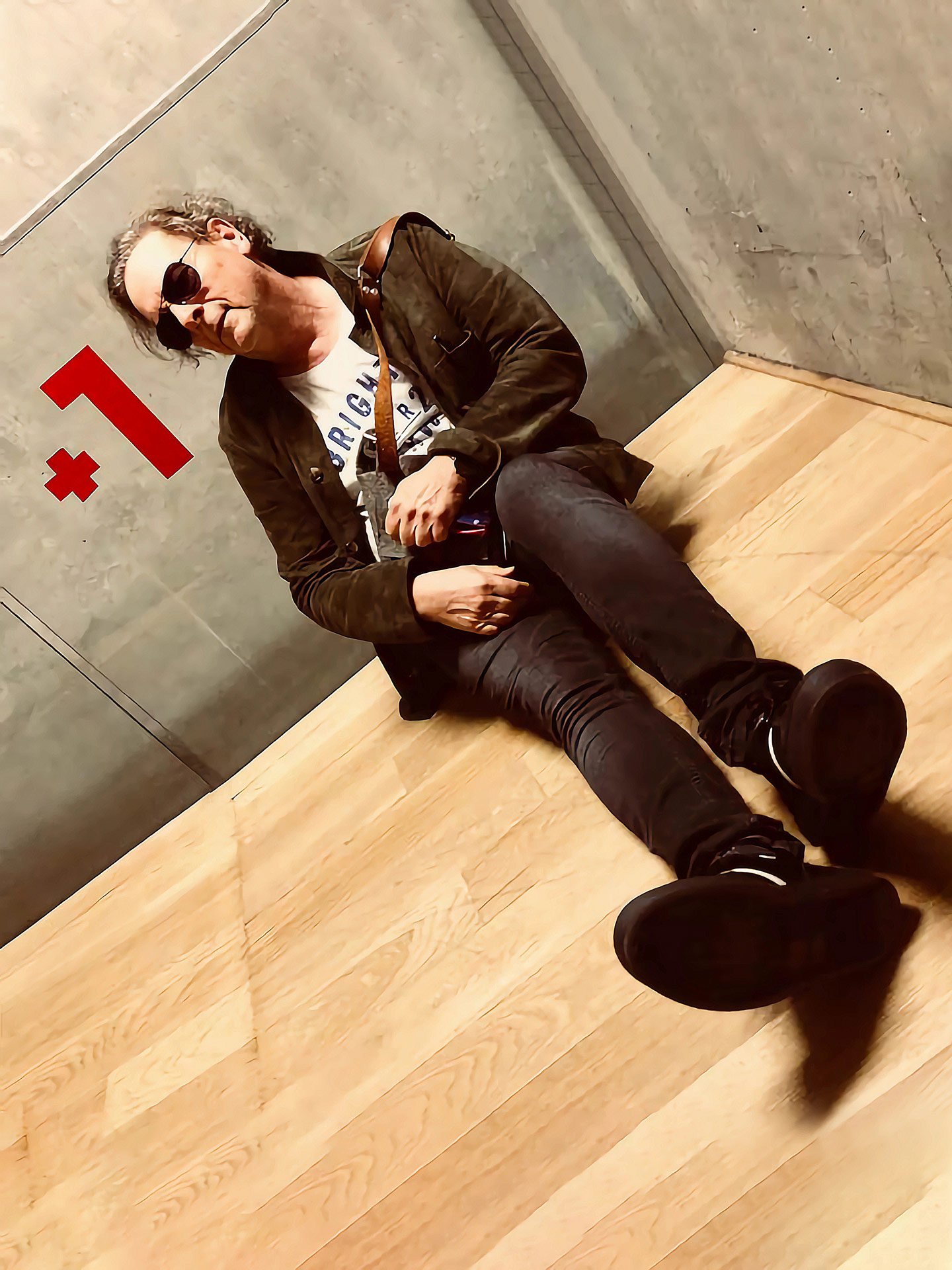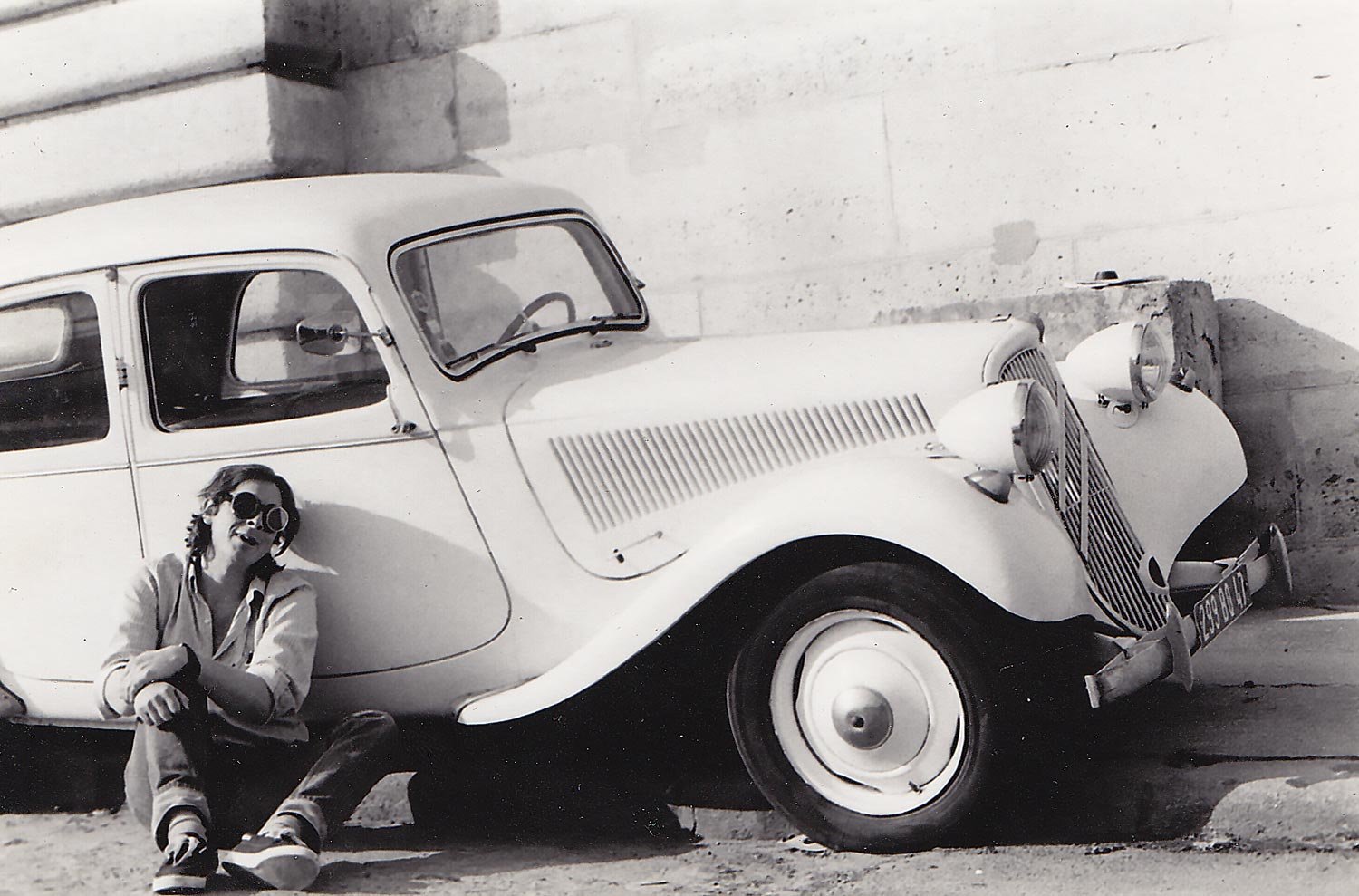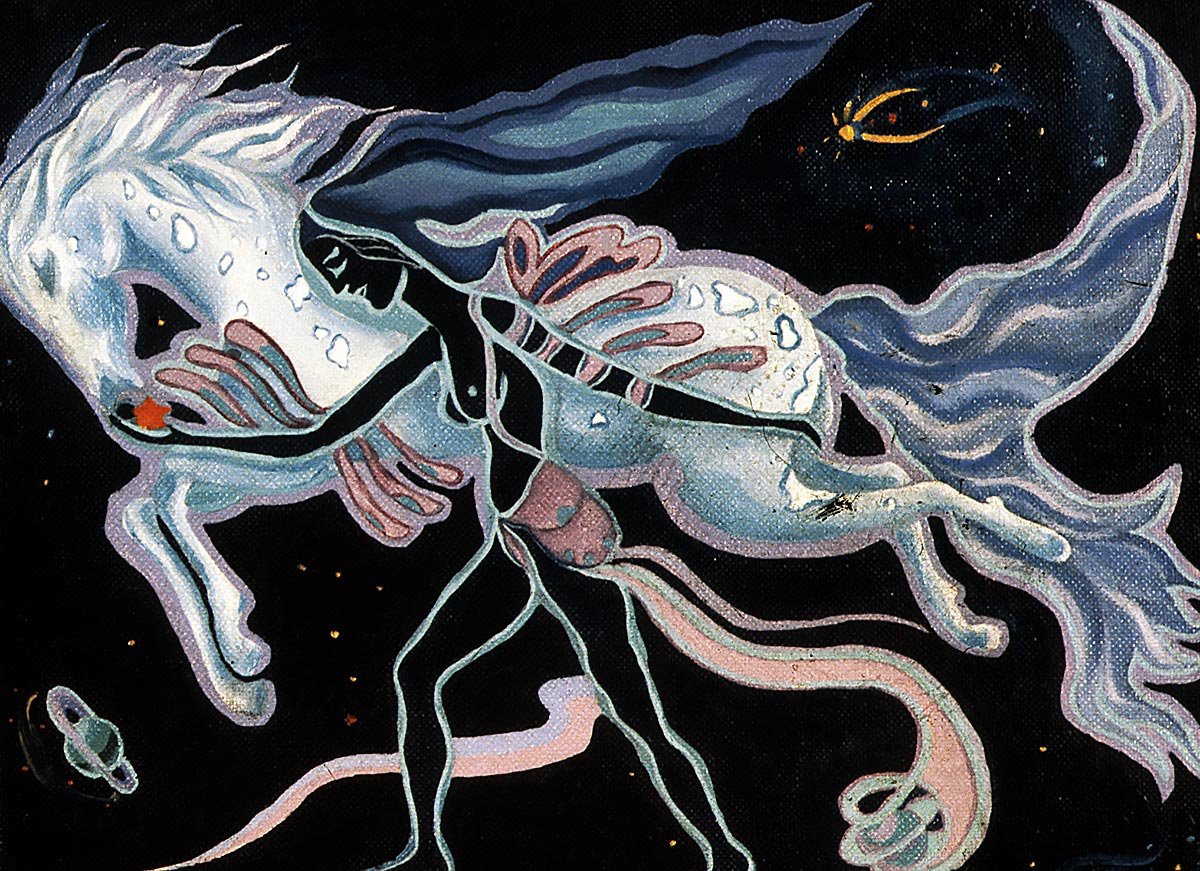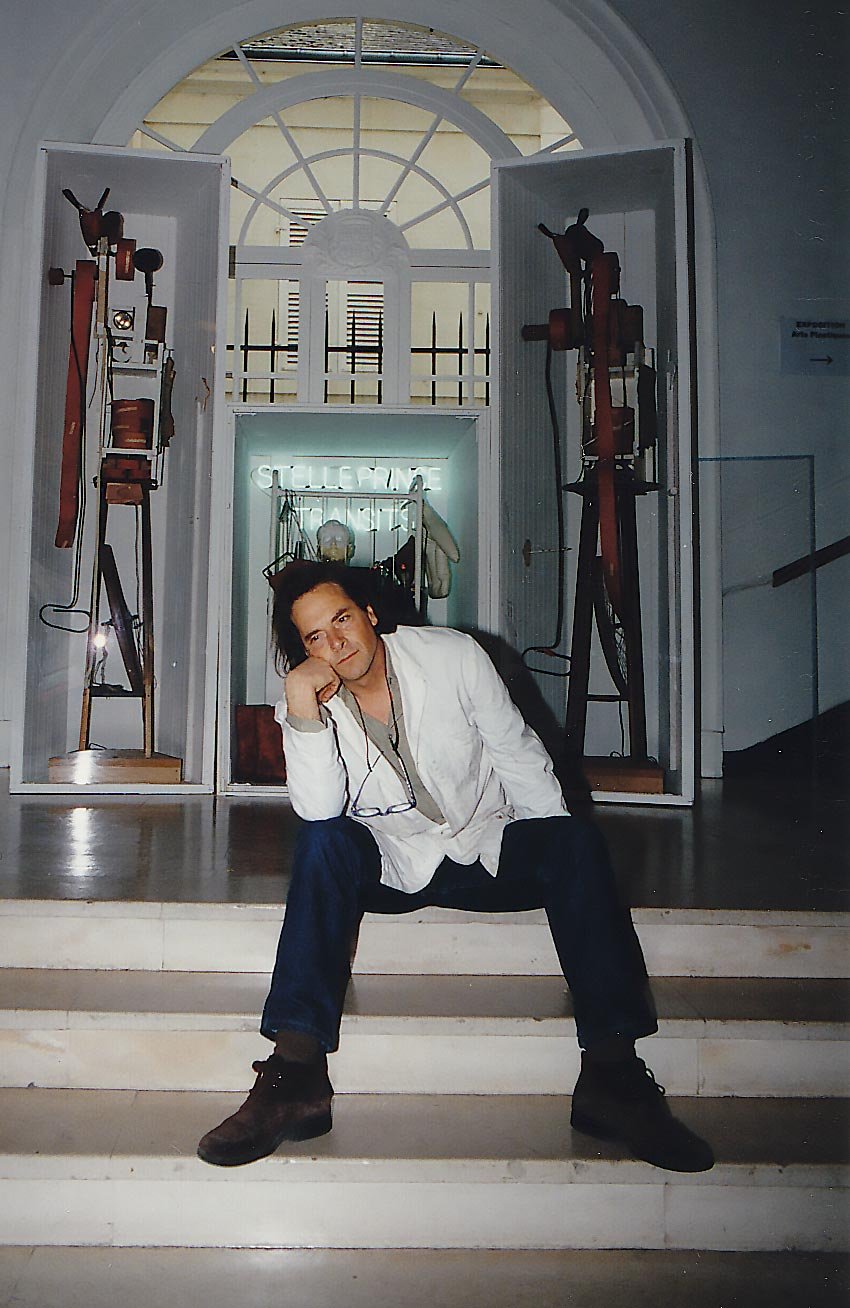The Artist
PATRICE STELLEST
YOUTH AND STUDIES
In 1970, at the age of 16, Stellest left Switzerland to move to the United States. He quickly met Charles LeMaire, a costume designer for Marilyn Monroe and a three-time Oscar winner for his creations. After seeing Stellest’s costume sketches, LeMaire offered to mentor him. However, already influenced by the work of Max Ernst, Stellest envisioned a different artistic path and respectfully declined the offer.
A few years later, he received a scholarship from the State of California and joined the Walt Disney Institute of Applied Arts, where he specialized in experimental art under the guidance of Jules Engel, the chief animator of Fantasia, who became his mentor.
Subsequently, Stellest enrolled at the Art Center College of Design in Pasadena, California, where he studied Art and Cinematography. There, he directed a series of short films blending music and experimental art, convinced early on of the promising future of music videos as a medium. Following this vision, he won the 1st prize at the Art Center for his short film Portrait 1982, which advocated for the role of women in the art world. He also presented his work to the team of the cinematographer of Oliver Stone’s film The Doors, who were in search of new ideas and visual inspiration.
EARLY CAREER
In 1984, Stellest moved to Paris with his partner. Together, they took over the studio formerly used by Pop Art artists Claus Oldenburg and James Rosenquist. His partner was pregnant when, following in the footsteps of Max Ernst, they left Paris for the Touraine region. It was there that Stellest created the Cosmic Art movement with Jim Cortland, an artist based in the area.
Within this new movement, he painted The Sower of Artenay, which caught the eye of New York gallery owner Sandra Gehring. At the time, Stellest was not interested in working with galleries, preferring a more direct relationship with art collectors.
It was also in Touraine, inspired by the abandoned metal pieces found on old farms, that Stellest taught himself basic welding techniques to create his first sculptures. Transforming the function of objects to give them a second life and new meaning was what drove him. His son Pablo was born in April 1985.
In 1989, Stellest moved with his family to the south of France, marking the start of a very prolific period. He learned to sculpt metal by becoming an assistant to Greek sculptor Costa Coulentianos and connected with a variety of artists and influencers, including César, Dora Maar, Ulrich Zieger, René Durbach, as well as Léo Castelli, Harald Szeemann, and M. Tate. This circle of friends encouraged him in various ways to advance his art and express his new ideas and concepts. During this time, he also created the emblematic pastel of his painting career, The Hug.
RENEWABLE ENERGY SCULPTURE
ART WITH NATURE
In 1993, Stellest withdrew to pursue his deepest artistic aspirations. During this period, he collaborated with Martin Bühler, Jean Tinguely’s assistant, and physicist-artist Bernard Gitton on a new style of artwork centered on a message that had always been present in his mind: the defense of nature and the environment. The masterpiece of this movement is undoubtedly The Solar Head. Designed to function at its own pace using solar energy, this sculpture was the first in a long series of interactive artworks, combining cutting-edge technology with experimental art and a fundamental message.
In 1999, Stellest exhibited the works of his new movement at the Palais des Arts in Marseille. Immediately afterward, he showcased his pieces at the château of Béatrice de Andia, director of artistic action for the city of Paris, during an exhibition centered around nature. Finally, in 2001, he was the guest of honor at Palexpo in Geneva, where he officially presented Trans Nature Art (TNA) to the art world.
To this day, his exhibitions remain rare, and his works are primarily held in private collections from Japan to Uruguay, including London, Zurich, Monte Carlo, and Paris. Stellest exhibits almost exclusively at events accessible to the general public, striving through his art to convey his message of respect for nature and the environment. Firmly advocating for peace, he supports a new kind of energy, both social and individual, through what he calls “Universal Acupuncture.
MUSIC
The 2000s and the introduction of Trans Nature Art into the world of contemporary art marked a fundamental turning point in Stellest’s career, as he decided to diversify his means of expression. He immersed himself wholeheartedly in music, teaching himself composition and guitar. This journey proved fruitful, leading him to meet prominent figures in the international music scene and eventually to the creation of his band, Stellest and Lino & The Planetary Vagabonds. The group embarked on an endless tour, sharing its music wherever the wind takes them.
At the same time, Stellest continued his work in the realm of renewable energy sculptures with the creation of the Starman, the star-headed man, which inspired both the aesthetics of his band and his audiovisual compositions. In 2019, the University of Chicago introduced a course on Stellest’s art, and he continues to present his art and message in schools, colleges, high schools, and universities, aiming to raise awareness among future generations about the urgent environmental challenges we must address.
The Artist

PATRICE STELLEST

YOUTH AND STUDIES
In 1970, at the age of 16, Stellest left Switzerland to move to the United States. He quickly met Charles LeMaire, a costume designer for Marilyn Monroe and a three-time Oscar winner for his creations. After seeing Stellest’s costume sketches, LeMaire offered to mentor him. However, already influenced by the work of Max Ernst, Stellest envisioned a different artistic path and respectfully declined the offer.
A few years later, he received a scholarship from the State of California and joined the Walt Disney Institute of Applied Arts, where he specialized in experimental art under the guidance of Jules Engel, the chief animator of Fantasia, who became his mentor.
Subsequently, Stellest enrolled at the Art Center College of Design in Pasadena, California, where he studied Art and Cinematography. There, he directed a series of short films blending music and experimental art, convinced early on of the promising future of music videos as a medium. Following this vision, he won the 1st prize at the Art Center for his short film Portrait 1982, which advocated for the role of women in the art world. He also presented his work to the team of the cinematographer of Oliver Stone’s film The Doors, who were in search of new ideas and visual inspiration.

EARLY CAREER
In 1984, Stellest moved to Paris with his partner. Together, they took over the studio formerly used by Pop Art artists Claus Oldenburg and James Rosenquist. His partner was pregnant when, following in the footsteps of Max Ernst, they left Paris for the Touraine region. It was there that Stellest created the Cosmic Art movement with Jim Cortland, an artist based in the area.
Within this new movement, he painted The Sower of Artenay, which caught the eye of New York gallery owner Sandra Gehring. At the time, Stellest was not interested in working with galleries, preferring a more direct relationship with art collectors.
It was also in Touraine, inspired by the abandoned metal pieces found on old farms, that Stellest taught himself basic welding techniques to create his first sculptures. Transforming the function of objects to give them a second life and new meaning was what drove him. His son Pablo was born in April 1985.
In 1989, Stellest moved with his family to the south of France, marking the start of a very prolific period. He learned to sculpt metal by becoming an assistant to Greek sculptor Costa Coulentianos and connected with a variety of artists and influencers, including César, Dora Maar, Ulrich Zieger, René Durbach, as well as Léo Castelli, Harald Szeemann, and M. Tate. This circle of friends encouraged him in various ways to advance his art and express his new ideas and concepts. During this time, he also created the emblematic pastel of his painting career, The Hug.

RENEWABLE ENERGY SCULPTURE
ART WITH NATURE
In 1993, Stellest withdrew to pursue his deepest artistic aspirations. During this period, he collaborated with Martin Bühler, Jean Tinguely’s assistant, and physicist-artist Bernard Gitton on a new style of artwork centered on a message that had always been present in his mind: the defense of nature and the environment. The masterpiece of this movement is undoubtedly The Solar Head. Designed to function at its own pace using solar energy, this sculpture was the first in a long series of interactive artworks, combining cutting-edge technology with experimental art and a fundamental message.
In 1999, Stellest exhibited the works of his new movement at the Palais des Arts in Marseille. Immediately afterward, he showcased his pieces at the château of Béatrice de Andia, director of artistic action for the city of Paris, during an exhibition centered around nature. Finally, in 2001, he was the guest of honor at Palexpo in Geneva, where he officially presented Trans Nature Art (TNA) to the art world.
To this day, his exhibitions remain rare, and his works are primarily held in private collections from Japan to Uruguay, including London, Zurich, Monte Carlo, and Paris. Stellest exhibits almost exclusively at events accessible to the general public, striving through his art to convey his message of respect for nature and the environment. Firmly advocating for peace, he supports a new kind of energy, both social and individual, through what he calls “Universal Acupuncture.

MUSIC
The 2000s and the introduction of Trans Nature Art into the world of contemporary art marked a fundamental turning point in Stellest’s career, as he decided to diversify his means of expression. He immersed himself wholeheartedly in music, teaching himself composition and guitar. This journey proved fruitful, leading him to meet prominent figures in the international music scene and eventually to the creation of his band, Stellest and Lino & The Planetary Vagabonds. The group embarked on an endless tour, sharing its music wherever the wind takes them.
At the same time, Stellest continued his work in the realm of renewable energy sculptures with the creation of the Starman, the star-headed man, which inspired both the aesthetics of his band and his audiovisual compositions. In 2019, the University of Chicago introduced a course on Stellest’s art, and he continues to present his art and message in schools, colleges, high schools, and universities, aiming to raise awareness among future generations about the urgent environmental challenges we must address.
